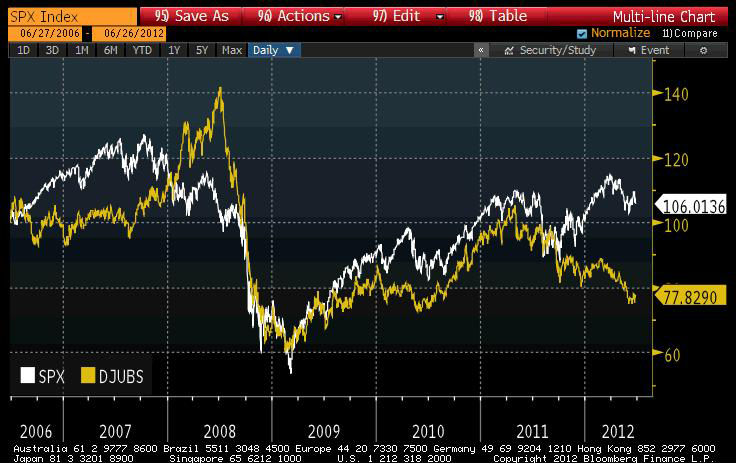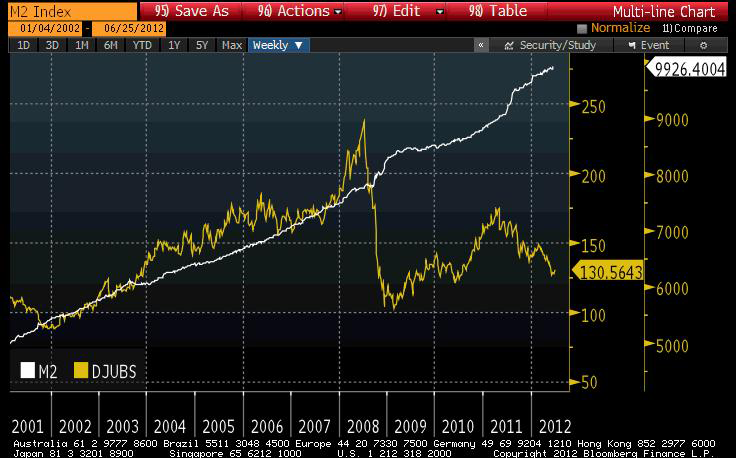Writing a column these days is challenging, because the observations are sometimes out-of-date before you finish writing. At the least, it is risky to wait a day to share observations. On Friday, I was ready to write about the incredible negativity surrounding commodities. On Thursday and Friday of last week, I was tuned into CNBC while visiting with customers, and it seemed all that anyone could mention was the decline in commodities – even though they were up, on balance, on Friday.
There was some joker who said that the only way oil “can go up from here” is if there is some crisis in the Middle East. That’s just crazy talk, and I’d planned to write about the fact that when you get such crazy talk and no one is really questioning it, it’s normally a sign that just about everyone who can be short something is already short. But it was Friday, and sometimes I don’t write an article on Friday.
So of course, on Monday the DJ-UBS commodity index rallied 1.8%, while the S&P declined 1.6%.
The bounce in commodities by itself is not unusual; like stocks, commodities bounce around all the time. It is somewhat more unusual, at least by the standards of the last couple of years, to see them move sharply in opposite directions. Prior to 2008, believe it or not, commodities and stocks didn’t always move together. Beginning in mid-2008, they moved together more often than not, as the chart below (Source: Bloomberg) – which shows the S&P and the DJ-UBS index, normalized to June 27, 2006 – illustrates.
It made some sense when commodities and stocks both cratered in 2008, and some sense when they began to move up together in 2009 since the extraordinary efforts the Fed was making to increase liquidity should have affected both markets. But in late 2011, the two markets became uncoupled, with the commodity market moving lower partly because of a perception that more QE was not forthcoming, and stocks moving higher because QE wasn’t needed (I’ve noted elsewhere that I think that’s erroneous analysis, but I think that characterizes the perception). Still, the basic wiggles were similar.
I wouldn’t make any huge conclusions about one day’s price action, even if yesterday was the first time since December 11th, 2008 that the DJ-UBS rose at least 1.5% and the S&P declined at least 1.5%. That divergence was formed over a long period of time, after all. But it is worth noting. (I just wish I’d made the speculation on Friday!)
The question, of course, is whether the divergence will be resolved with commodities rallying, equities declining, both, or with the markets moving in the same directions at different speeds (for example, stocks rallying slowly while commodities rally hard). Since commodities are also out-of-whack relative to money supply, a variable to which they ought to be closely related (see Chart, source Bloomberg, below), my expectation is that commodities are more likely to catch up with stocks in the context of higher prices for commodities.
This view, as I am duty-bound to point out, has nothing to do with the fact that domestic and indeed global growth is looking worse and worse. Yes, New Home Sales yesterday reached the highest level in two years, albeit at a shadow of the normal level of new home turnover. But Thursday’s Philly Fed index was abysmal (-16.6 vs expectations for flat). China is experiencing a slowdown. I just saw this note about India. And then there’s Europe.
On Monday both Spain and Cyprus formally requested EU aid – Cyprus saying that its direct exposure to Greece led to this sorry pass. Speaking of Greece, is it a good sign that the newly-appointed finance minister has already resigned due to illness, leading to a postponement of the Troika’s visit to Athens? Speaking of Spain, is it a good sign that a Forbes-associated blogger is taunting that country about its obviously-optimistic request for funds?
The optimists on Europe say that the obvious pain associated with a euro breakup will ensure that the region comes together on a plan for Eurobonds or fiscal union. Aside from the unwarranted optimism that any large group of politicians could pull together a plan to make a ham sandwich by an arbitrary deadline…
Look, I understand that there are huge penalties for not putting together Eurobonds. I don’t think they’re any larger than the penalties for succeeding in putting together Eurobonds or a pan-European fiscal authority, but the timing of the failure is worse (for politicians, anyway). And I understand that European politicians are somewhat insulated from the pressure of the electorate because of the great cynicism of the masses in Europe (“Why throw them out? The new folks will do the same thing.”). But I don’t believe that democracy is dead in Europe, and if democracy means anything then it means the overwhelming opinion of the populace – as illustrated by the soccer-fan chants on Friday – might still matter. The Intrade market on the question “Any country currently using the euro to announce intention to drop it before midnight ET 31 Dec 2012” is 27%-30% at the moment. I think that seems low.
But in any event, the volatility is still with us, and seems likely to rise further in the weeks ahead rather than to recede. Some investors will continue to flee to Treasuries (10y yields down 7bps to 1.60% yesterday) or TIPS (10-year real yields down 5bps to -0.50%). But at these levels I don’t know why, for a flight-to-safety, I would hold those securities rather than T-bills. Or, for that matter, commodities! At this point, surely most of the bad news – and some fair bit of gratuitous sneering from bears – is in the price of commodities.
- English (UK)
- English (India)
- English (Canada)
- English (Australia)
- English (South Africa)
- English (Philippines)
- English (Nigeria)
- Deutsch
- Español (España)
- Español (México)
- Français
- Italiano
- Nederlands
- Português (Portugal)
- Polski
- Português (Brasil)
- Русский
- Türkçe
- العربية
- Ελληνικά
- Svenska
- Suomi
- עברית
- 日本語
- 한국어
- 简体中文
- 繁體中文
- Bahasa Indonesia
- Bahasa Melayu
- ไทย
- Tiếng Việt
- हिंदी
Pain Everywhere Except In The Commodity Pits
Published 06/26/2012, 12:26 AM
Updated 02/22/2024, 09:00 AM
Pain Everywhere Except In The Commodity Pits
Latest comments
Loading next article…
Install Our App
Risk Disclosure: Trading in financial instruments and/or cryptocurrencies involves high risks including the risk of losing some, or all, of your investment amount, and may not be suitable for all investors. Prices of cryptocurrencies are extremely volatile and may be affected by external factors such as financial, regulatory or political events. Trading on margin increases the financial risks.
Before deciding to trade in financial instrument or cryptocurrencies you should be fully informed of the risks and costs associated with trading the financial markets, carefully consider your investment objectives, level of experience, and risk appetite, and seek professional advice where needed.
Fusion Media would like to remind you that the data contained in this website is not necessarily real-time nor accurate. The data and prices on the website are not necessarily provided by any market or exchange, but may be provided by market makers, and so prices may not be accurate and may differ from the actual price at any given market, meaning prices are indicative and not appropriate for trading purposes. Fusion Media and any provider of the data contained in this website will not accept liability for any loss or damage as a result of your trading, or your reliance on the information contained within this website.
It is prohibited to use, store, reproduce, display, modify, transmit or distribute the data contained in this website without the explicit prior written permission of Fusion Media and/or the data provider. All intellectual property rights are reserved by the providers and/or the exchange providing the data contained in this website.
Fusion Media may be compensated by the advertisers that appear on the website, based on your interaction with the advertisements or advertisers.
Before deciding to trade in financial instrument or cryptocurrencies you should be fully informed of the risks and costs associated with trading the financial markets, carefully consider your investment objectives, level of experience, and risk appetite, and seek professional advice where needed.
Fusion Media would like to remind you that the data contained in this website is not necessarily real-time nor accurate. The data and prices on the website are not necessarily provided by any market or exchange, but may be provided by market makers, and so prices may not be accurate and may differ from the actual price at any given market, meaning prices are indicative and not appropriate for trading purposes. Fusion Media and any provider of the data contained in this website will not accept liability for any loss or damage as a result of your trading, or your reliance on the information contained within this website.
It is prohibited to use, store, reproduce, display, modify, transmit or distribute the data contained in this website without the explicit prior written permission of Fusion Media and/or the data provider. All intellectual property rights are reserved by the providers and/or the exchange providing the data contained in this website.
Fusion Media may be compensated by the advertisers that appear on the website, based on your interaction with the advertisements or advertisers.
© 2007-2025 - Fusion Media Limited. All Rights Reserved.
